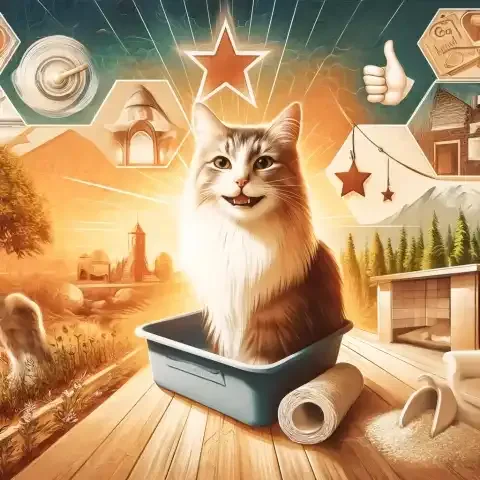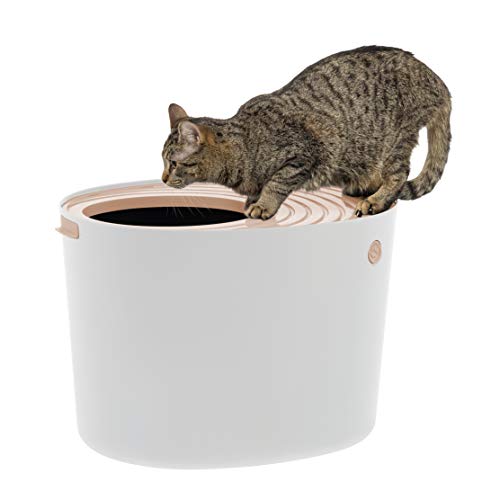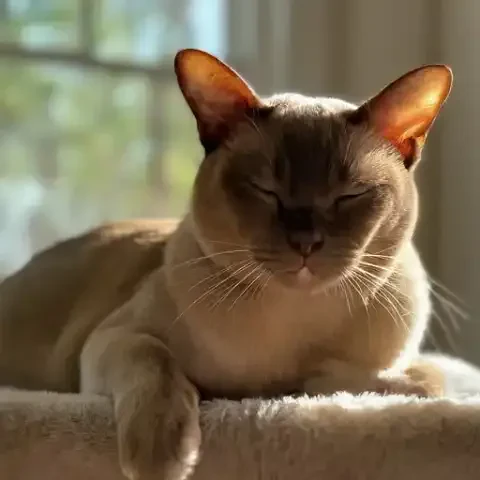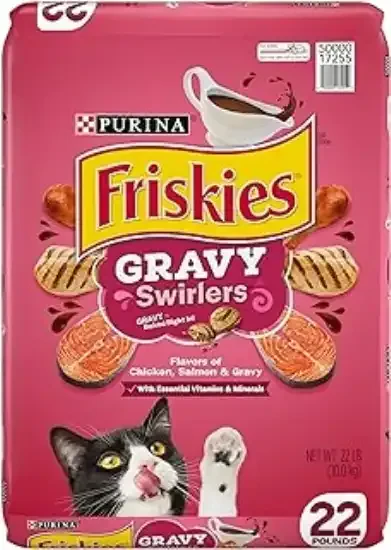Imagine this: you've just brought home a fluffy new kitten, or perhaps you're dealing with a long-standing battle against litter box odors that seem to permeate every corner of your house. Maybe your otherwise perfect feline friend has suddenly decided the litter box is no longer an acceptable place to do their business. Sound familiar? The truth is, choosing the right cat litter and litter box is far more crucial to feline happiness (and your sanity) than many people realize. In fact, a surprising number of behavioral issues and even health problems can be linked back to a cat's dissatisfaction with their bathroom setup.
This guide is designed to tackle the common problems cat owners face – the endless scooping, the pervasive smell, the frustrating litter tracking, and the dreaded scenario of a cat rejecting their box altogether. We're here to provide a comprehensive resource, helping you navigate the overwhelming world of litter and box options. By understanding your cat's individual needs and the various products available, you can create a litter box solution that leads to a happier, healthier cat and a cleaner, fresher-smelling home. We will cover everything from understanding your cat, the different litter and box types, how to make smooth transitions, and keeping up with maintenance.
Before you even start browsing the pet store aisles, it's essential to consider your cat as an individual. Just like people, cats have unique preferences and needs that can significantly impact their litter box habits. A kitten, for example, will have different requirements than a senior cat. Kittens often benefit from low-dust litters with a softer texture and smaller granules that are gentle on their developing paws. Adult cats may have already developed strong preferences based on their past experiences, so introducing changes requires careful consideration. Senior cats, on the other hand, might need a litter box with a low entry point to accommodate arthritis or other mobility issues. Softer litters can also be beneficial for older cats with sensitive paws.
Beyond age, certain health conditions can also influence your choices. If your cat has respiratory problems, such as asthma, a low-dust or hypoallergenic litter is absolutely crucial to minimize irritation. Similarly, if either you or your cat suffers from allergies, it's important to identify potential allergens in litters, such as strong fragrances or excessive dust. Cats with urinary tract issues might benefit from litters that allow you to easily monitor changes in urine color or clumping, providing early warning signs of potential problems. If your cat has had surgery, a softer litter will prevent discomfort.
A cat's personality plays a huge role, too. Some cats are notoriously finicky, and finding the right combination of scent, texture, and box type might involve some trial and error. In multi-cat households, you'll likely need multiple boxes, and you might even find that your cats have different litter preferences. Cats that are enthusiastic diggers or tend to spray urine might require high-sided boxes, covered boxes, or the strategic placement of litter mats to contain the mess. If your cat has a history of avoiding the litter box, it's vital to address any underlying causes, which could range from medical problems to stress, before attempting to introduce new litters or boxes. A slow, gradual transition is always key.
Now, let's dive into the vast world of cat litter itself. The options can seem endless, but they generally fall into a few main categories. Clay-based litters are the most traditional and widely available. Within this category, you have clumping and non-clumping varieties. Clumping clay litter, typically made from sodium bentonite, is a popular choice due to its excellent odor control and ease of scooping. The litter forms solid clumps when wet, making it simple to remove waste and maintain a cleaner box. However, clumping clay can be quite dusty, which can be a problem for cats or owners with respiratory sensitivities. It's also heavier than some other options, not biodegradable, and prone to tracking around the house. Despite these drawbacks, it remains a good all-around choice, especially for multi-cat households with good ventilation.
Non-clumping clay litter, often made from calcium bentonite or other absorbent clays, is generally less expensive than its clumping counterpart. It's absorbent, but it doesn't form those solid clumps, meaning you'll need to replace the entire litter box contents more frequently. Odor control is also typically less effective than with clumping clay. This type of litter can be a good budget-friendly option for single-cat households where frequent changes aren't a burden.
Silica gel litter, also known as crystal litter, represents a different approach. These litters are made from synthetic silica gel beads, which are incredibly absorbent. They excel at odor control, are generally low-dust, and can last much longer than clay litters before needing a complete change. However, silica gel litter is usually more expensive, and some cats dislike the texture, which can feel hard and sharp under their paws. It can also be quite noisy when the cat digs. It's not biodegradable, either. This type of litter is a great choice for cats and owners who are sensitive to dust, and for those who prioritize long-lasting odor control and less frequent litter box maintenance.
The market for natural and biodegradable litters has exploded in recent years, driven by growing environmental awareness and a desire for healthier alternatives. Wood-based litters, made from pine, cedar, or other woods, offer a natural scent that some cats find appealing (while others may find it too strong). These litters are biodegradable and often compostable, though you should always check your local regulations regarding pet waste disposal. They are typically low-dust, but their clumping ability can vary, and some cats may not like the texture, which can range from pellets to sawdust to granules. Wood litters are a good option for environmentally conscious owners, provided their cats tolerate the scent.
Paper litter, made from recycled paper, is another eco-friendly choice. It's very low-dust and has a soft texture, making it ideal for cats with allergies, post-surgical recovery, or kittens. However, paper litter tends to be less absorbent than other types, requiring more frequent changes, and it's not always the best at controlling odors.
Wheat litter offers a natural clumping alternative to clay. It's biodegradable, often low-dust, and provides good odor control. However, it's important to store wheat litter properly to prevent attracting pantry pests, and some cats may have allergies to wheat.
Corn litter is another clumping, biodegradable option that's also relatively lightweight. However, there's a potential risk of aflatoxins, a type of mold that can grow on corn, so careful monitoring is essential. Some cats may also be tempted to eat corn litter, which is not ideal.
Grass litter is becoming increasingly popular. It has a fine texture that many cats find appealing, clumps well, and provides good odor control. One downside is that it can sometimes be challenging to find in stores.
Walnut shell litter, made from crushed walnut shells, is a sustainable and low-dust option with good odor control. However, the dark color of the litter can make it harder to monitor urine for changes that might indicate health problems, and some cats may have allergies to walnuts.
To simplify things, consider this: Clumping clay is a workhorse, good for general use and odor control, but dusty. Non-clumping clay is cheaper but needs more frequent changes. Silica gel is excellent for odor control and low dust, but pricier. Wood offers a natural scent and is biodegradable, but the scent can be strong. Paper is soft and gentle, great for sensitive cats, but less absorbent. Wheat and corn are natural clumping options, but have potential drawbacks (pests, aflatoxins). Grass has a popular fine texture and good clumping, but is newer to the market. Lastly, walnut is sustainable and low-dust, but the dark colour can be a concern.
Choosing the right litter box is just as important as selecting the right litter. The general rule of thumb is that the litter box should be at least 1.5 times the length of your cat, measured from the tip of their nose to the base of their tail. This gives them enough space to comfortably turn around, dig, and cover their waste. Kittens will obviously need smaller boxes initially, while senior cats may need lower entry points due to mobility issues. In multi-cat households, the golden rule is one box per cat, plus one extra. This helps to minimize competition and stress, which can lead to litter box aversion.
The variety of litter box types available can be overwhelming. Open litter pans are the simplest and most affordable option. They provide easy access and good ventilation, but they offer minimal odor control, and litter can be easily scattered. These are best for cats who don't mind being exposed and for owners who are diligent about scooping.
Covered or hooded litter boxes provide a greater sense of privacy for the cat and help to contain odors and reduce litter tracking. However, the enclosed space can trap odors inside, making it unpleasant for some cats. They may also be too small for larger cats, and ventilation can be a concern if the box isn't cleaned regularly. These are a good choice for cats who prefer privacy and for owners who want to minimize mess.
Top-entry litter boxes are designed to significantly reduce litter tracking. The cat enters and exits through an opening on the top, which helps to knock litter off their paws as they leave. These boxes are also great for cats who like to dig enthusiastically. However, they are not suitable for senior cats or cats with mobility problems, and some cats may be hesitant to use them initially.
Self-cleaning litter boxes automate the scooping process, which can be a huge convenience for busy owners. They typically use a rake or other mechanism to remove waste into a separate compartment, reducing odor and minimizing manual labor. However, these boxes are significantly more expensive, can be noisy, and some cats may be frightened by the moving parts. They also require electricity and are susceptible to mechanical failure.
Corner litter boxes are designed to fit snugly into a corner, saving valuable floor space. However, they can sometimes be too small for larger cats. These can be a great solution for smaller homes or apartments.
High-sided litter boxes are similar to open pans but have taller sides to help prevent litter scatter, especially from cats who spray urine or dig vigorously. These boxes can be a good compromise between open and covered options, but kittens and elderly cats may have a hard time entering.
Litter box enclosures or furniture pieces are designed to conceal the litter box and blend it into your home decor. They can be quite stylish and provide extra privacy for your cat. However, they can be expensive, may be difficult to clean thoroughly, and ventilation can be a concern if not designed properly.
The placement of the litter box is just as critical as the box itself. Cats prefer quiet, low-traffic areas where they won't be disturbed. Avoid placing the box near noisy appliances, busy hallways, or their food and water bowls. Cats don't like to eliminate near where they eat. In multi-cat homes, it's essential to have boxes in multiple locations to reduce competition and stress. Ensure that the box is easily accessible, especially for older cats or those with mobility issues. Maintain good ventilation to help control odors, and try to keep the box in a consistent location; avoid moving it around frequently, as this can confuse your cat.
Transitioning your cat to a new type of litter or a new litter box requires patience and a gradual approach. Abrupt changes can lead to litter box aversion. When introducing a new litter, start by mixing a small amount of the new litter with the old litter. Gradually increase the proportion of new litter over several days or even weeks, allowing your cat to adjust to the new scent and texture.
If you're introducing a new litter box, place the new box next to the old one. Let your cat explore the new box at their own pace. You can even put some of their used litter in the new box to help them recognize it as a bathroom area. Positive reinforcement is key. Reward your cat with treats or praise when they use the new litter or box.
Observe your cat's behavior closely during the transition. If they show signs of hesitation or avoidance, slow down the process. If your cat completely refuses the new litter or box, you may need to try a different type. Sometimes, litter box aversion can be a sign of an underlying medical or behavioral problem, so it's always a good idea to consult with your veterinarian if you're having difficulties.
Even the best litter and box combination won't be effective without proper maintenance and hygiene. Scooping the litter box at least once a day, and preferably twice, is essential for removing waste and controlling odors. The frequency of complete litter changes depends on the type of litter you use. Clay litters generally require more frequent changes than silica gel or some natural litters. A good rule of thumb is to change the litter completely every 1-4 weeks, depending on the type and your cat's habits.
When you do a full litter change, wash the litter box thoroughly with mild soap and water. Avoid using harsh chemicals or cleaning products with strong scents, as these can deter your cat from using the box. Litter box liners can make cleaning easier, but some cats dislike the feel of them. If you use liners, make sure they fit snugly and don't bunch up, as this can also be a deterrent.
For extra odor control, you can sprinkle a thin layer of baking soda at the bottom of the box before adding fresh litter. Activated charcoal filters can also help to absorb odors. In some cases, an air purifier placed near the litter box can make a significant difference. Dispose of used litter properly according to your local regulations. Some litters can be composted, while others need to be bagged and disposed of in the trash.
Choosing the best cat litter and box is an investment in your cat's well-being and your own peace of mind. It's about finding the right combination that meets your cat's individual needs and preferences while also keeping your home clean and odor-free. Don't be afraid to experiment with different options, and remember that a gradual transition is key to success. A well-maintained litter box, chosen with care and consideration, can significantly improve your cat's quality of life and strengthen the bond you share. Taking the time to get it right will pay off in a happier, healthier cat and a more harmonious home.







